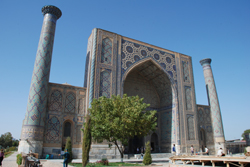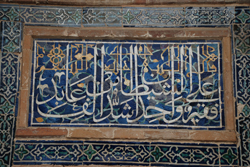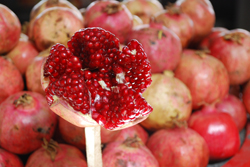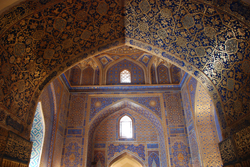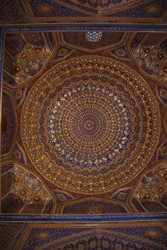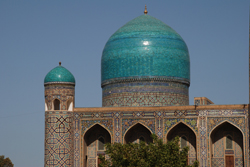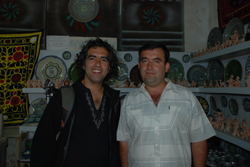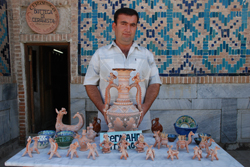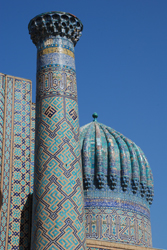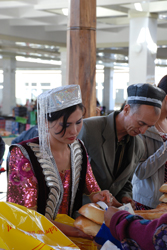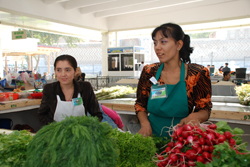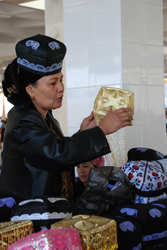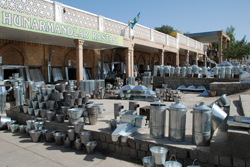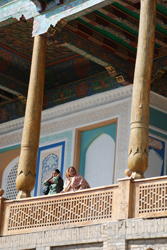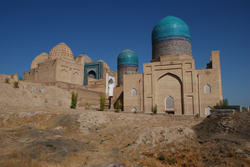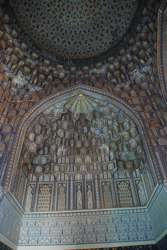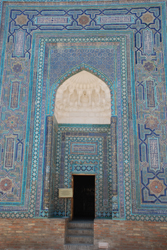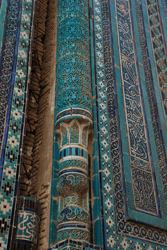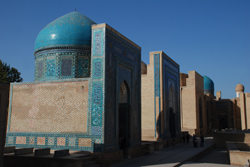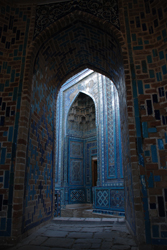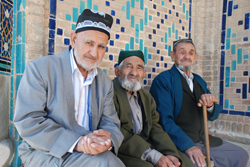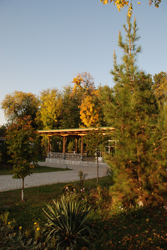Samarkand: Reveling in Registan
6 October, 2008, 04:44 am in "Uzbekistan"
All the photos I've seen and stories I've read didn't prepare me for Samarkand. Or maybe its man-made beauty shocked me since for the past couple months we've been in places of natural beauty but lacking an abundance of historic beautiful sites. This morning was devoted to visiting Registan. Although surrounded by more modern city structures, the buildings of the Registan still dwarf them. This impressive threesome of medressas dominate the part of town we are in with turquoise domes, tiled faces and minarets. The beige bricks of the buildings are adorned with turquoise, blue, green and white tiles. The tile work has fascinating designs and patterns, flowers become stars, and swirls become flowers. The brick and tiles harmoniously shine against the light blue sky. Columns soar with ornate tiled crowns. Everywhere there are patterns but the effect is calming rather than clashing.
In the courtyard, surrounded on 3 sides by these medressas (schools) it is hard to decide where to look first. I chose Ulugbek's. It has 2 beautiful minarets with tile brick patterns which direct the eye upward to its tiled calligraphy and geometrical “stalactite” capitals (muqama). The “body” of the building is solid and rectangular. Mostly it is decorated with brick tile patterns but pointed arches add curves and serve as the base for ornate swirled vines and flower tile work.
In the courtyard, surrounded on 3 sides by these medressas (schools) it is hard to decide where to look first. I chose Ulugbek's. It has 2 beautiful minarets with tile brick patterns which direct the eye upward to its tiled calligraphy and geometrical “stalactite” capitals (muqama). The “body” of the building is solid and rectangular. Mostly it is decorated with brick tile patterns but pointed arches add curves and serve as the base for ornate swirled vines and flower tile work.
The architect was Kavomidden Sherozi whose name means he was from Shiraz. Looking at these buildings devoted to science and seeing the skillful craftsmanship really makes one see what an amazing place Samarkand must have been in its heyday.
The central entrance section (Iwan), is where the simpler patterns give way to a riot of ornamentation and an incredible variety of tile work. Gardens of stars, flowers, and filigree blossom from the walls. Some are cut tiles, other glazed patterns on tile. The top is a beautiful section of star patterns merging into flowers, contrasting colors of glazed work against patterned terracotta. A geometric patterned window grate reveals the courtyard, baring you from what's inside but giving one the feeling of glimpsing into a secret place.
One thing that impressed me about the architecture and decoration is the division of space. It is as if the architecture is dividing the world of patterns into manageable spaces. There seems to be something philosophical about it-- presenting different ideas, a balance between sensible grounded brick tiles and poetic vines and flowers finding the parts that make a whole. At eye level, the tile-work was broken by a strip of calligraphy carved into marble and below that was simple geometric designs in blue tile.
The inside courtyard had four doorways and numerous rooms surrounded it. Above the door of each was a passage in Arabic. Rowshan translated one, “Gain science in this world for the next.” Unfortunately, the rooms had been made into souvenir shops with sellers badgering us to come inside making it difficult to peacefully soak in the beauty of the designs.
The central entrance section (Iwan), is where the simpler patterns give way to a riot of ornamentation and an incredible variety of tile work. Gardens of stars, flowers, and filigree blossom from the walls. Some are cut tiles, other glazed patterns on tile. The top is a beautiful section of star patterns merging into flowers, contrasting colors of glazed work against patterned terracotta. A geometric patterned window grate reveals the courtyard, baring you from what's inside but giving one the feeling of glimpsing into a secret place.
One thing that impressed me about the architecture and decoration is the division of space. It is as if the architecture is dividing the world of patterns into manageable spaces. There seems to be something philosophical about it-- presenting different ideas, a balance between sensible grounded brick tiles and poetic vines and flowers finding the parts that make a whole. At eye level, the tile-work was broken by a strip of calligraphy carved into marble and below that was simple geometric designs in blue tile.
The inside courtyard had four doorways and numerous rooms surrounded it. Above the door of each was a passage in Arabic. Rowshan translated one, “Gain science in this world for the next.” Unfortunately, the rooms had been made into souvenir shops with sellers badgering us to come inside making it difficult to peacefully soak in the beauty of the designs.
In the courtyard I was struck by the calming and cooling feeling which radiated from the tiles from the cool colors: blues, greens, turquoises. One type of tile-work patterns repeated in the doorways reminded me of blue and white snowflakes. A cool oasis in the desert.
One woman who was trying to get us into her shop told another seller in Tajik Rowshan was a tourist. Rowshan responded that he wasn't. “Look around! Everything is Persian.” He challenged her to read the writing above her shop. When she acknowledged that she couldn't read it, he asked, “Who is the tourist?” and she said, “I am.”
My first impression of the Tilla Kori Medressa (built 1646-1660 during the reign of Yalangtush Bakhodir) was it was more down to earth with simpler tile work than the other medressas. It was only 1 story. Then we walked into the mosque. It was redolent of gold, white, and blue filigree rising to intricate leaves and vines which create an optical illusion of a domed roof. It was the Baroque or Rococo equivalent in Islamic Architecture.
My first impression of the Tilla Kori Medressa (built 1646-1660 during the reign of Yalangtush Bakhodir) was it was more down to earth with simpler tile work than the other medressas. It was only 1 story. Then we walked into the mosque. It was redolent of gold, white, and blue filigree rising to intricate leaves and vines which create an optical illusion of a domed roof. It was the Baroque or Rococo equivalent in Islamic Architecture.
It one wing was a museum with interesting old photos of monuments around town before restoration. On a return visit, Rowshan found the restorers had made a mistake on the painted interior painting several Arabic calligraphic pieces backwards. We also learned the Soviet restorers had added domes to the main structure and its minarets.
In the museum was a short paragraph on the history of the site. Ulugbek's 15th century constructions were the medressa, Khonako, a caravansaray, two mosques (Mukatta and Kukaldosh. In the 17th century, Yalangtush Bahodur built the Medressa Sherdor on the ruined Khanako and the Tilla Kori Madressa on the ruins of the caravansaray.
In the courtyard of Tilla Kori we saw a ceramics workshop. We are a little skeptical of these “workshops” because most seem to just be souvenir stores. We were surprised, however, to find an actual artist in the ceramics workshop. He was very gracious and when he learned Rowshan was also a ceramics artist, he told him about the different styles in his shop, about the processes used and unlocked the next cell over and showed Rowshan the kiln he'd made. Among the pieces he had for sale were “suzan” designs from Rishtan--solid colored pieces with tezhip designs carved into the pigment with a needle, Green and blue Rishtan pieces with blue and green designs, and his own work-- whimsical figurines of white beards, camels, and dragons as well as Samarkand style bowls with designs etched in and tinted sections of transparent colored glazes.
In the courtyard of Tilla Kori we saw a ceramics workshop. We are a little skeptical of these “workshops” because most seem to just be souvenir stores. We were surprised, however, to find an actual artist in the ceramics workshop. He was very gracious and when he learned Rowshan was also a ceramics artist, he told him about the different styles in his shop, about the processes used and unlocked the next cell over and showed Rowshan the kiln he'd made. Among the pieces he had for sale were “suzan” designs from Rishtan--solid colored pieces with tezhip designs carved into the pigment with a needle, Green and blue Rishtan pieces with blue and green designs, and his own work-- whimsical figurines of white beards, camels, and dragons as well as Samarkand style bowls with designs etched in and tinted sections of transparent colored glazes.
The 3rd Medressa, Sher Dor's striking features include some odd tile lions (that look like tigers) with a sun rising behind with a rather cartoonish looking face. It looks like they are working on restoring the main arch tile work. Another striking feature is the turquoise fluted, tiled domes.
Inside were (surprise surprise!) souvenir shops. One did have musical instruments including dafs, a “chang” (santour), and lots of rebabs.
I'm sitting in the area across from the Tillya Kori Madressa thinking how beautiful the tile-work looks from a distance-- like blue and tan lace. The tile-work of Tillya Kori which from close-up seemed heavy from a distance becomes light filigree. Unfortunately, there are a lot of aggressive beggars-- women and children who attach themselves onto you. Rowshan had to laugh when he noticed a beggar woman pulled out her cell phone to take a call. I guess everyone has cell phones these days.
I'm sitting in the area across from the Tillya Kori Madressa thinking how beautiful the tile-work looks from a distance-- like blue and tan lace. The tile-work of Tillya Kori which from close-up seemed heavy from a distance becomes light filigree. Unfortunately, there are a lot of aggressive beggars-- women and children who attach themselves onto you. Rowshan had to laugh when he noticed a beggar woman pulled out her cell phone to take a call. I guess everyone has cell phones these days.
[ View 1 Comments
|
]
Samarkand: Guys, Girls and the Shah-I-Zinda
5 October, 2008, 04:45 am in "Uzbekistan"
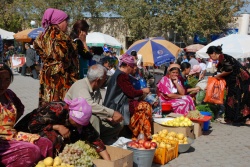 For our ride from the border to Samarkand, the other passenger in our taxi was a 2nd wife in a polygamous marriage. Her husband had 2 wives and she was the youngest. She had been talking about multiple wives and had said, “There is war if he can't support them.” We asked her if there is ever war between her and the other wife. She said, “No” and that her husband was a good man and supported them both as well as all their children. And she was dressed well (though women here usually are). She told us Samarkand makes the best bread and highly recommended the sweets.
For our ride from the border to Samarkand, the other passenger in our taxi was a 2nd wife in a polygamous marriage. Her husband had 2 wives and she was the youngest. She had been talking about multiple wives and had said, “There is war if he can't support them.” We asked her if there is ever war between her and the other wife. She said, “No” and that her husband was a good man and supported them both as well as all their children. And she was dressed well (though women here usually are). She told us Samarkand makes the best bread and highly recommended the sweets.The best place to find bread in Samarkand is the Siob Bazaar: a clean and attractive open bazaar with marble vendor tables, white ceiling and a bread area with carved wooden columns. The market is kept clean by sweepers who patrol the aisles disregarding any shoppers feet or bags in their way. It's filled with good smells and attractively arranged foods. We bought some pomegranates which Rowshan squeezed in their skins into juice.
Rowshan got into a conversation with some women who were giggling about his hair (thinking he wouldn't understand). Somehow the conversation turned to how he could marry 4 of them and the one who was caught laughing about his hair would have the job of combing it. One would cook, another make salad (they were greens vendors) but when he asked who'd clean, one pointed at me. I guess I'd better watch out for these Uzbek/Tajik women.
A couple days later, at one of our Internet cafe stops, Rowshan pointed out a young man peering over the shoulder of a young woman chatting using a messenger program. Rowshan laughed, “We used to do that at the computer center to get the user names of people and send them messages.” Then, while checking my Facebook account, I saw I had a message from an Uzbek guy 20 years younger than me which simply said, “Hi”. I joked to Rowshan that if he was going to collect potential wives at the bazaar, I was going to collect young computer guys at Internet cafes.
Back at the bazaar, a spice vendor tried to sell Rowshan saffron to which he replied, “I'm from Iran. The best saffron is from Mashad, Iran.” Then he tried to sell cumin to which Rowshan replied, “The best cumin is from Kerman, also in Iran.” Aside from food, there were also women selling traditional Uzbek hats.
Back at the bazaar, a spice vendor tried to sell Rowshan saffron to which he replied, “I'm from Iran. The best saffron is from Mashad, Iran.” Then he tried to sell cumin to which Rowshan replied, “The best cumin is from Kerman, also in Iran.” Aside from food, there were also women selling traditional Uzbek hats.
We found an open air cafe and got plov, salad, and tea. It was a popular place so when Rowshan saw to old men with long white beards carrying soup bowls, he offered them places at our table. They tourists as well, visiting from “Leninbad”. It took us a little while to figure out they were from Khojand which used to be called Leninbad.
Across from the bazaar, we found some metal workers. These were practical metal workers, not souvenir makers. They were making tools: scythes, shovel heads, hoe heads as well as aluminum pipes, boxes and sink structures. They all called over to us and wanted to chat, especially when they found out Rowshan spoke Farsi (we are in a predominantly Tajik speaking area still). After that we peeked at the Hazrat-Hizr Mosque which has a beautiful painted ceiling.
Across from the bazaar, we found some metal workers. These were practical metal workers, not souvenir makers. They were making tools: scythes, shovel heads, hoe heads as well as aluminum pipes, boxes and sink structures. They all called over to us and wanted to chat, especially when they found out Rowshan spoke Farsi (we are in a predominantly Tajik speaking area still). After that we peeked at the Hazrat-Hizr Mosque which has a beautiful painted ceiling.
Shah-I-Zinda
The Shah-I-Zinda complex is a narrow avenue of mausoleums, most decorated with tiles of glazed terracotta work. There are a huge variety of decorative styles. Some have tile-work inside and out, others are just white washed (maybe they were tiled but the tile-work got destroyed), and others are filled with painted designs.
We spent quite a while wandering through. The last section had two mausoleums with beautiful glazed terracotta designs-- a colored glass covered version of the type of clay work we'd seen at Aysha Bibi in Taraz and Uzgen. The most religiously important mausoleum though is for Mohamad's cousin Abbas who is credited for spreading Islam in Central Asia. It contained a mosque, prayer room, and the tomb. In the prayer room a man sang prayers while everyone sat absorbing the beauty of the space.
We walked back into the center and then towards the Russian part of town because I needed to use the Internet. One of the wonderful things about Samarkand was it was a city with its own history and identity before the Russians got here. It feels more like a Middle Eastern city like Istanbul, cities in Iran and Morocco. It has an appreciation for beauty and culture and a strong Central Asian character instead of Soviet. That said, there is a Russian area with straight tree lined streets and Russian/Soviet buildings. It also has cafes, restaurants and a pretty park. Everything closed early Sunday night, but we did get some hot Samarkand bread which is delicious, cheese, tomatoes and cucumbers.
[ View 2 Comments
|
]
The Road to Samarkand
4 October, 2008, 04:32 pm in "Uzbekistan"
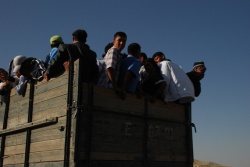 “Mr. Finish?” the floor lady asked as we handed the key to her. She asks this whenever we leave, “Finish?”, “Mr. Finish?” I think it is the only English she knows. Oh well, at least she tries. I always answer in Russian, “No, we are staying a couple more days/1 more day, etc.” She is not as bad as some of the Russian women who work in the hotels, oblivious to the fact that the Soviet Union is no more and they are now members of a market economy. Today when we left, some of the Tajik housekeepers who were watching TV with the floor manager, chatted a little with Rowshan. The Russian floor lady even joined in on the conversation in a friendly matter. Maybe the Tajik friendliness is rubbing off.
“Mr. Finish?” the floor lady asked as we handed the key to her. She asks this whenever we leave, “Finish?”, “Mr. Finish?” I think it is the only English she knows. Oh well, at least she tries. I always answer in Russian, “No, we are staying a couple more days/1 more day, etc.” She is not as bad as some of the Russian women who work in the hotels, oblivious to the fact that the Soviet Union is no more and they are now members of a market economy. Today when we left, some of the Tajik housekeepers who were watching TV with the floor manager, chatted a little with Rowshan. The Russian floor lady even joined in on the conversation in a friendly matter. Maybe the Tajik friendliness is rubbing off.On the road to Samarkand we saw lots of cotton fields and corn that was “as high as an elephant's eye”. There were sunflower fields, donkeys, sheep, cows, goats and 1 camel. We went from fertile irrigated fields to extremely dry hills like petrified grass covered sand dunes with graceful curves. From there we came to more dry dirt hills-- some looking like they were made from wasp nest paper. Others looked like pieces of the flat earth had been forced up revealing cliffs around the edges of a diagonal plane. For a section, the earth became red and formed curved and rounded red boulders and wind carved shapes. Later we came to mountains covered with rocks. The colors and shapes of the landscapes were surprising in their variety but shared the characteristic of dryness.
The road was the best we've driven on in a while. At one point it even became a 4 lane divided highway. We could almost have been in California. Then the car had to slow down to navigate between a flock of sheep in one lane and a man riding a donkey in the other. We ascended a mountain covered with boulders. The colors of the valley below were softened by the dusk.
We got to Samarkand around 7PM. It was dark but we even through the darkness we could see the tantalizing shapes of domes against the night sky.
We got to Samarkand around 7PM. It was dark but we even through the darkness we could see the tantalizing shapes of domes against the night sky.



